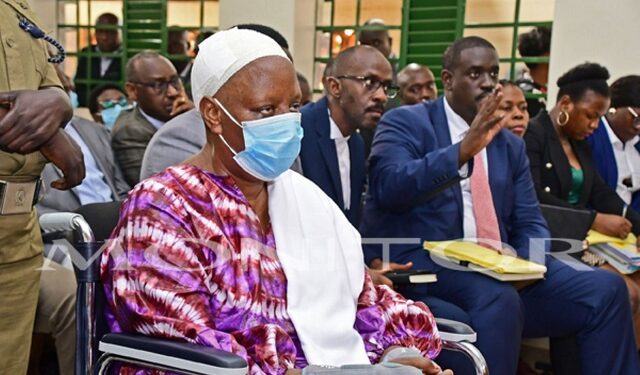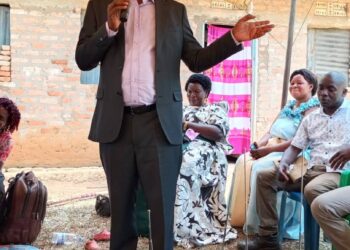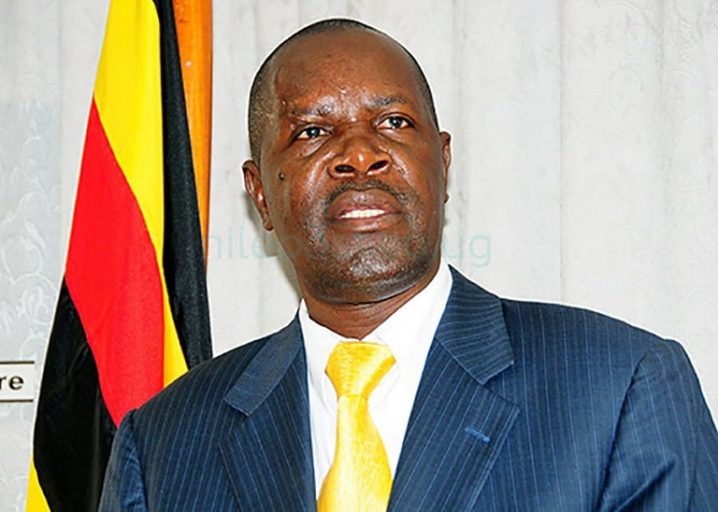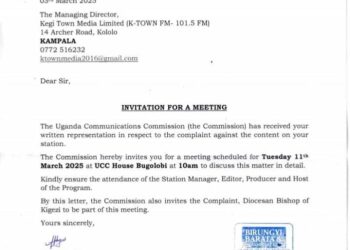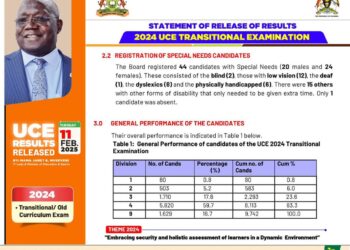KAMPALA – Defence lawyers in the ongoing Katanga murder trial have grilled pathologist Dr. Richard Ambayo over allegations that he leaked his own report to the Uganda People’s Defence Forces (UPDF) before it was presented in court.
During cross-examination, the lawyers led by Elison Karuhanga accused Dr. Ambayo of sharing his postmortem report with an online blog and two UPDF soldiers, who used it to initiate an inquest into Katanga’s death.
However, Dr. Ambayo denied the allegations, insisting that he did not share the report before it was tendered in court.
During heavy cross exmaination, Dr. Ambayo, the pathologist who examined Henry Katanga’s body, also retracted his earlier testimony, stating he doesn’t know Martha Nkwanzi Katanga, one of the suspects. This contradicts his previous statement that Martha helped him identify Katanga’s body before a forensic examination.
Defense lawyer Karuhanga, questioned Dr. Ambayo’s credibility, suggesting he may have been biased by Investigating Officer Detective Sgt. Beteise. “It’s possible for an expert to be biased,” Karuhanga said. “Cognitive bias can occur when someone gives you information that influences your work.” Dr. Ambayo agreed, stating, “Yes, I’m aware of the effects of bias.”
The lawyers pointed out inconsistencies in Dr. Ambayo’s testimony, including his earlier statement that the entry wound was on the right side of the head, contradicting his postmortem report. The defense team presented a photo of Katanga’s body showing lacerations on the left side of the head, which Dr. Ambayo maintained could be exit wounds.
The hearing of the Katanga murder case continues before the High Court, with defense lawyers cross-examining Dr. Ambayo. The lawyers insist the gun entry wound is located on the left side of the head, not the right side as stated in his postmortem report. They argue Dr. Ambayo is either incompetent or biased by Detective Sgt. Beteise, leading him to conclude Katanga was shot on the right.
Dr. Ambayo clarified, “We confirmed the identification because the request came with the name. I cannot confirm that Martha Nkwanzi, the daughter, identified the body.” However, he previously stated, “The body was identified by Nkwanzi in my presence.” The defense argues Martha was not present at the mortuary.
According to Police form 48A, the deceased allegedly shot himself after a domestic violence incident. The defense team confronted Dr. Ambayo with a photo of Katanga’s body showing lacerations on the left side of the head, but he maintained exit wounds can also have lacerations.
The defense lawyers further accuse Dr. Ambayo of leaking his report to an online blog and two UPDF soldiers, who used it to initiate an inquest into Katanga’s death. Dr. Ambayo denies releasing the report before its presentation in court.
Vertabtim
10:27 am – Court Proceedings
Judge enters the courtroom. Court clerk calls for the Katanga case file.
Wakooli: My lord, Accused Number One is appearing via Zoom, while the co-accused persons are present in court. For the prosecution, we appear as before. Mr. Mwesigwa Rukutana is appearing on a watching brief. The accused’s representation remains the same as yesterday, except for Jet Tumwebaze.
Bruce: As Dr. Ambayo takes the stand, we’d like to raise a concern about media coverage, specifically Stanley Ndawula. We request that he be warned.
Judge: Is he present in court?
Bruce: No, my lord.
Judge: Inform him to refrain from sensational reporting, or we will impose sanctions.
Judge: Shall we proceed? Are you ready?
Karuhanga: My lord, should Dr. Ambayo take the stand or be seated?
Judge: Let him take the stand, unless he’s already fatigued. (laughter in court)
Karuhanga: Elison Karuhanga for the record. Yesterday, Dr. Ambayo, you mentioned the term “margin of abrasion.” Is it fair to say that’s the mark left on the skin when a bullet enters the body?
Dr. Ambayo: That’s not correct.
Karuhanga: Is it a scraping of the skin as the bullet moves forward?
Dr. Ambayo: No.
Karuhanga: In your previous testimony, you stated that you didn’t observe a margin of abrasion. Correct?
Dr. Ambayo: Correct.
Karuhanga: Can you explain why?
Dr. Ambayo: The explosion effect and physical effect of the projectile blew the tissue off at near contact, which is why I didn’t see the ring of abrasion.
Karuhanga: You mean it comes out as a ball of fire?
Karuhanga: Also, the bullet comes with hot gases, correct?
Dr. Ambayo: Correct.
Karuhanga: And the burning effect caused the ring effect…
Dr. Ambayo: Not correct.
Karuhanga: Otherwise, an abrasion would be a must for an entry wound.
Dr. Ambayo: It’s not a must.
Karuhanga: An abrasion ring can only happen at the point of entry.
Dr. Ambayo: True. My lord, I’d like to amend that – most times, with rare exceptions.
Karuhanga: Doctor, please look at Prosecution Exhibit 5G. (Court clerk hands him the exhibit, a picture from the autopsy)
Karuhanga: Can you confirm that what you see is a hole?
Dr. Ambayo: Correct.
Karuhanga: And can you confirm that you can’t see lacerations and burning abrasion?
Dr. Ambayo: You can only see them upon careful view.
Karuhanga: Where is the hole?
Dr. Ambayo: You can’t see it from a distance.
(Karuhanga moves closer to the Dr Ambayo, who becomes uncomfortable)
Dr. Ambayo: (nervously) They are visible, but very small.
Karuhanga: Doctor, please look at Exhibit P5F. On the wound on the left, you testified that the explosion removed the ring.
Dr. Ambayo: That is correct.
Karuhanga: Let’s examine this wound. Confirm to us that this is a wound on the left. Would I be right to say I can see the star shape?
Dr. Ambayo: Yes, I can clearly see the lacerations.
Karuhanga: So, it’s fair to conclude that the wound on the right has lacerations and the one on the left has microscopic ones.
Karuhanga: My lord, I have a few more questions.
Judge: Proceed.
Karuhanga: Doctor, are you aware of the term “bias”?
Dr. Ambayo: I’m aware.
Karuhanga: Would I be fair to say that it’s possible for an expert to be biased?
Dr. Ambayo: Let him rephrase the question.
Karuhanga: Is it possible for an expert to be biased?
Dr. Ambayo: Not possible.
Karuhanga: A biased person’s mind is already made up, irrespective of the evidence before them.
Dr. Ambayo: I’m not biased.
Karuhanga: I haven’t said you are biased. Doctor, you’re also aware of the term “confirmation bias”?
Dr. Ambayo: No.
Karuhanga: This is where you’re already biased before.
Dr. Ambayo: Okay.
Karuhanga: I want to suggest to you that Detective Beitese told you that the entry wound was on the right.
Dr. Ambayo: Not true.
Karuhanga: Beitese and others had already formed an opinion and communicated to you that the entry wound was on the left.
Dr. Ambayo: I don’t know about that.
Karuhanga: Did you have any conversation with Beitese about the entry wound?
Dr. Ambayo: No.
Karuhanga: That would be strange, because in his Dr Ambayo statement, he said that when he entered the room…
Prosecutor Muwaganya interrupts.
Karuhanga: Did Beitese share his view with you?
Dr. Ambayo: No.
Karuhanga: Was that the date the postmortem report was sent out?
Dr. Ambayo: It wasn’t sent on that very day.
Karuhanga: So, the date is backdated.
Dr. Ambayo: No.
Karuhanga: So, your report was forwarded to Bugolobi.
Dr. Ambayo: It was picked up by the liaison officer.
Karuhanga: Are you aware that your report was first published on an online publication, Chimp Reports, on November 21, 2023? I want him to look at the report and confirm whether what was published is the same as in his report.
Dr. Ambayo: My lord, it’s so faint.
Karuhanga: Let the court look at it to determine its faintness.
Judge: Admits it for identification.
Wakooli stands up and objects to the identification.
Karuhanga: You said there was a star-shaped bullet wound measuring… I want you to look at P5G, that is exactly that wound, and you have measured. Can you show the court how you measured?
Judge: He showed us yesterday.
Dr. Ambayo: (illustrates to the court)
Karuhanga: All the tears leave a wound.
Dr. Ambayo: A tear leaves a wound.
Karuhanga: Your claim that the entry wound is larger than the exit wound is not measured.
Dr. Ambayo: Not true.
Karuhanga: There are deliberate falsehoods.
Dr. Ambayo: They are not there.
Karuhanga: But if we find one…
Judge: He is not the one who establishes that.
Karuhanga: You testified that prior to the examination, the body was identified.
Dr Ambayo: We confirmed the identification as the body came with an identifier.
Karuhanga: I put it to you that Martha Nkwanzi Katanga didn’t identify the body.
Dr Ambayo: She identified and signed for the body.
Karuhanga: I notify you that Martha was nowhere near the mortuary at that time, your claim is a lie.
Dr Ambayo: That can’t be true.
Karuhanga: Last point, doctor. I want to confirm we are dealing with a gunshot wound. What request came to you?
Dr Ambayo: It’s alleged the deceased shot himself after a domestic wrangle.
Judge: Your time is over.
Karuhanga: Must obliged.
Kabega: I have some more questions. Doctor, you said the body came with a request.
Dr Ambayo: Correct.
Kabega: You said you filled the postmortem report.
Dr Ambayo: Correct, but it was a team effort.
Kabega: Even the judge is getting confused with you.
Dr Ambayo: Which one, 48B?
Kabega: Do you have another postmortem report besides 48B?
Dr Ambayo: Yes.
Kabega: Where did you get the information you filled before the examination?
Dr Ambayo: I got it from parts of 48B and 48A.
Kabega: Does it indicate the time it was made?
Dr Ambayo: No.
Kabega: Does the request indicate the name of the officer who made the request?
Dr Ambayo: No.
Kabega: You said bodies are brought to the mortuary by vehicle.
Dr Ambayo: Yes.
Kabega: Does the vehicle’s number appear on the request form?
Dr Ambayo: No.
Kabega: The body came with police form 48A.
Dr Ambayo: Yes.
Kabega: The police form 48A gives a short history.
Dr Ambayo: Yes.
Kabega: The brief history says the deceased shot himself after a domestic quarrel, and you proceeded with the examination based on that information.
Dr Ambayo: Yes.
Kabega: Doctor, you said you have a long career as a pathologist.
Dr Ambayo: Four years.
Kabega: In your career, you’ve come across cases where people have committed suicide.
Dr Ambayo: Yes.
Kabega: Cases like this one, where the head is a target area.
Dr Ambayo: Yes.
Kabega: Your finding was the shooting was at near short range.
Dr Ambayo: Yes.
Kabega: Close ranges are associated with suicide.
Dr Ambayo: I wasn’t at the scene; I only did the examination.
Kabega: Read the passage.
Dr Ambayo: There were no defense injuries or limb injuries.
Kabega: So, in your findings, you rule out that the accused was not engaged in a defensive encounter?
Dr Ambayo: I cannot tell.
Kabega: Where did the bullet go?
Dr Ambayo: I didn’t see the bullet, so I cannot say whether it went upwards. Half of the bullet was left to the right side, more downwards in relation to the entry wound. I don’t know which direction the bullet took after it exited.
Kabega: Dr Ambayo, my lord, I said “after” because I’m not a forensic expert.
Kabega: Are you in a position to tell the court the size of the ammunition used and also from which type of gun it would have come from?
Dr Ambayo: Straight no.
Kabega: Doctor, it’s your evidence that it’s a team of officers when carrying out the postmortem.
Dr Ambayo: Yes.
Kabega: Doctor, is there any other projectile that can cause a star-shaped wound?
Dr Ambayo: My lord, the question is not clear.
Kabega: Let me put it this way: you know what a stray bullet is. When it hits a wall, its shape may be deformed.
Dr Ambayo: Yes or no.
Kabega: If it hits metal, it can hit and bounce off.
Dr Ambayo: It depends.
Kabega: Assuming it hits a target and later hits a body.
Dr Ambayo: Not in this context, not a star-shaped wound. It can cause a dissimilar wound but not necessarily a star-shaped one.
Kabega: Doctor, do you work for the police?
Dr Ambayo: Correct.
Kabega: Are you aware that it’s the police investigating this matter, and it’s the police asking you to carry out the postmortem?
Dr Ambayo: But I’m a specialized pathologist.
Kabega: You know what conflict of interest means.
Dr Ambayo: I don’t know.
Kabega: You don’t know what conflict of interest means.
Dr Ambayo: I don’t.
Kabega: You are in the police force; it’s the same force investigating, and it has even indicated to you what they wanted. Do you think that report is credible?
Dr Ambayo: The request did not come with what the police force wanted.
Kabega: At City Mortuary, there are other pathologists not attached to the police.
Dr Ambayo: Yes, my lord, they are there, but I’m not sure of the number.
Kabega: For fairness’ sake, wouldn’t it have been wise to distance yourself from this examination so that it’s done by a person who is fairer?
Dr Ambayo: It would not have been fairer because I was on duty at that time.
Kabega: Doctor, we have evidence that the weapon used in this case could have been a double-barreled gun, and from your postmortem report, you indicate a SOCO carrying out a number of activities, then swabs for DNA. We have evidence that it was a double-barreled gun. You know in a double-barreled gun, you expect to have a blanket and bedsheets, and, of course, you know what goes on in a double bed; you are always with your better half.
Dr Ambayo: Not always (causing laughter in court).
Kabega: As a scientist, the gun can pick up DNA if you place it on the bed.
Dr Ambayo: I’m not a ballistic expert.
Kabega: But as a police officer, you would know that if you handle your phone, it will have your DNA.
Dr Ambayo: That is right, but it’s an area of ballistics.
Kabega: You carried out this examination with Doctor Male Mutumba; was he your senior?
Dr Ambayo: Yes, in terms of number of years.
Kabega: Since he is your senior, he should have been the one to write the postmortem report.
Dr Ambayo: Not true.
Kabega: Is he also a police officer?
Witness: I don’t know.
Kabega: I want to suggest to you that he is not here because he was retired four years ago.
Witness: My lord, I was given a summons to come here, and we agreed.
Kabega: Is it true that… took the photos?
Witness: That is true, but under the guidance of the team.
Kabega: Where did you get these photos from? Were they given to you by Penys?
Witness: No.
Kabega: Do they show when they were taken?
Witness: I confirm that there is no date.
Kabega: You can confirm from your report that fingerprints were lifted from the fingers of the deceased.
Witness: That is correct.
Kabega: Who lifted the fingerprints?
Witness: (no answer)
Kabega: My lord, that is all.
Judge: Are you doing re-examination, Muwaganya?
Muwaganya: Yes, but we shall not take more than 30 minutes.
Judge: Let’s come back at 2:30 pm.
Court adjourns.
Do you have a story in your community or an opinion to share with us: Email us at editorial@watchdoguganda.com


